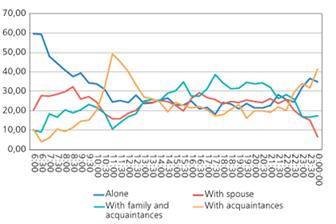Where and when do we eat?
- Time Use Survey data on eating out
- Looser patterns of mealtimes on weekends
- Eating alone and with others
- Occasions for eating out
- Less time spent at restaurants
- Income, age, attitudes and restaurant supply play a role in eating out
Koko dokumentti yhdell� sivulla
Eating alone and with others
Eating is considered a social activity, and meeting friends and offering hospitality are often given as the motivation for eating out. Drawing on data on spending time together with others in the Time Use Survey, I examined how often we eat with others. In Figure 5, spending time together is roughly classified into eating alone, with your spouse, with family members and/or acquaintances and only with acquaintances. No difference was made between having meals and snacks, and the figures include all types of eating that has been recorded as the main activity. Eating alone and together at different hours of the day was described by picking a ten-minute period at 30-minute intervals to include in the analysis. The analysis includes all participants of the Time Use Survey, or those aged 10 or over.
Figure 5. Eating alone and with others in 2009−2010. Percentage.

Source: Statistics Finland. Time Use Survey.
At the points in time examined, on average 30% of the respondents ate alone, 24% with family members and acquaintances and 23% with either their spouse or acquaintances only.
Figure 5 shows that we frequently have our breakfast alone, our lunch with acquaintances, and our evening meal with family members and acquaintances, but one person out of five also eats alone. Eating alone is associated with living alone. Of those who took part in the survey, some 24% lived alone, 39% with a partner and 37% as part of some other type of a family.
P�ivitetty 20.3.2013
